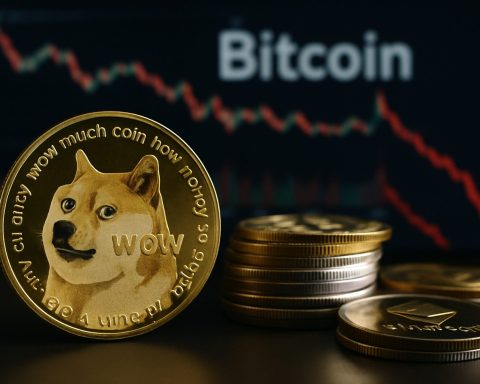- Ripple’s XRP Ledger bridges the gap between traditional finance and digital innovation through collaboration, not disruption.
- RippleNet, compared to ‘SWIFT for the blockchain era,’ offers fast and cost-effective cross-border payments.
- Major financial institutions like American Express and Santander have adopted Ripple’s system.
- Even giants like Bank of America and central banks in nations like Bhutan and Saudi Arabia are exploring Ripple’s technology.
- Ripple focuses on enhancing existing financial systems, rather than dismantling them, despite ongoing legal challenges with the SEC.
- Recognized by the World Economic Forum, Ripple advocates for integration, fostering a harmonious blend of traditional and digital finance.
- Ripple exemplifies that sustainable progress comes from collaboration, easing institutions into the digital era.
The glint of digital innovation often leaves traditional systems scrambling in its wake, yet Ripple, with its XRP Ledger, is bridging a gap few dared to navigate. Unlike its cryptocurrency siblings, whose anti-establishment ethos seeks to overturn the existing financial order, Ripple chooses diplomacy over disruption. By forging alliances with established banking institutions, Ripple is rewriting the playbook for blockchain technology in a move that speaks less of rebellion and more of symbiosis.
RippleNet emerges as a beacon of transformation, likened to ‘SWIFT for the blockchain era’. This network, built on Ripple’s robust consensus ledger, defies the outdated frameworks of cross-border payments by providing a lightning-fast and cost-effective alternative. Financial behemoths like American Express and Santander have already plugged into Ripple’s system, revealing a strategic pivot that signals an appetite for change without the overthrow of tradition.
Amidst this shifting landscape, even giants like Bank of America are dabbling with blockchain’s potential, drawn by the promise of speedier and more secure global transactions. Central banks around the world—Bhutan and Saudi Arabia to name notable adopters—are testing Ripple’s waters, intrigued by the network’s seamless integration and its harmonizing potential.
Ripple’s journey is not without its skirmishes, notably its ongoing legal tussle with the SEC. Yet, the vigor of its courtship with traditional finance speaks volumes. The company is not interested in dismantling the status quo but rather seeks to bolster it, offering tools and technologies that enhance efficiency and reduce costs for an audience acclimated to centuries-old systems.
This tactical approach shines in the recognition it garners, with accolades from the World Economic Forum as a champion of blockchain innovation in cross-border payments. The strategy is clear: instead of a revolution with torches and pitchforks, Ripple wields a pen and an olive branch. In a world teetering between steadfast tradition and digital innovation, Ripple stands to prove that sometimes the most effective change agents are those that weave new threads into the fabric of the old, crafting a tapestry of modern financial prowess intertwined with time-honored practices.
The takeaway: Ripple’s strategy is a testament to the value of integration over isolation. In a domain where total disruption may seem appealing, often the sustainable path is one that embraces collaboration—easing financial institutions into a digital future with the grace of an accommodating partner, not the shove of a relentless rival.
Ripple’s Transformative Role in the Global Financial Landscape: What You Need to Know
Ripple: Bridging Traditional and Blockchain Finance
Ripple’s impact on the financial world is marked by its unique approach to revolutionizing cross-border payment systems. At the heart of Ripple’s strategy is the XRP Ledger, a decentralized blockchain technology that aims to enhance existing financial processes rather than overthrow them. This positions Ripple distinctively among cryptocurrencies, known for their disruptive natures.
Key Features and Benefits of RippleNet
1. Speed and Cost-Effectiveness: RippleNet processes transactions in seconds, significantly faster than the traditional SWIFT system. Moreover, it reduces transaction costs, a huge advantage for global banks and remittance services.
2. Security and Transparency: The architecture of Ripple’s ledger provides high-level security with transparent transactions, benefiting both financial institutions and consumers.
3. Scalability: The Ripple network can handle a large number of transactions per second, making it highly scalable and suitable for global financial operations.
Real-World Use Cases
– Banking and Financial Institutions: Banks such as Santander and American Express leverage Ripple’s technology to streamline payment processing, offering enhanced efficiencies in international fund transfers.
– Central Bank Digital Currencies (CBDCs): Central banks, including those in Bhutan and Saudi Arabia, are exploring Ripple for implementing and enhancing digital currency frameworks.
Industry Trends and Market Forecasts
– Rapid Adoption: With institutions recognizing the benefits, blockchain integration in finance is set to grow exponentially. A Markets and Markets report anticipates the blockchain financial market to reach USD 21 billion by 2025, with Ripple as a primary player.
– Strategic Partnerships: Ripple continues to forge numerous partnerships, highlighting its commitment to integration with existing financial systems rather than radical shifts.
Controversies and Legal Challenges
Ripple’s ongoing legal battle with the Securities and Exchange Commission (SEC) over the classification of XRP as a security is a major point of contention. The outcome of this case could have significant implications for the cryptocurrency market at large.
Pros and Cons Overview
– Pros: Offers rapid and low-cost transactions, strong strategic partnerships, supportive for CBDC development, and provides high security.
– Cons: Legal uncertainties around XRP, dependency on banks for broad adoption, and potential transaction privacy concerns.
Expert Insights and Predictions
Experts believe Ripple’s model might inspire more blockchain technologies to seek compatible paths with traditional finance, fostering broader acceptance and implementation across industries.
Actionable Recommendations
– Financial Institutions: Consider pilot testing RippleNet for lower-risk transactions to evaluate benefits over current systems.
– Investors: Keep an eye on legal developments regarding Ripple as they could impact market prices significantly.
– Consumers: If engaged in frequent cross-border transactions, explore financial services utilizing RippleNet for potentially lower costs and faster service.
For more on the latest in financial technology and blockchain development, visit Ripple and stay informed on emerging fintech trends.






